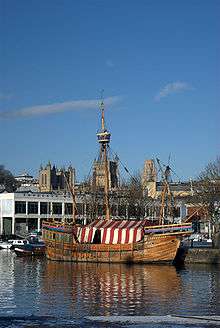Matthew (ship)
The Matthew is a replica of a caravel[1] sailed by John Cabot in 1497 from Bristol to North America, presumably Newfoundland. After a voyage which had got no further than Iceland, Cabot left again with only one vessel, the Matthew, a small ship (50 tons), but fast and able. The crew consisted of only 18 men. The Matthew departed 2 May 1497[2]. He sailed to Dursey Head (latitude 51°36N), Ireland, from where he sailed due west, expecting to reach Asia. However, landfall was reached in North America on 24 June 1497. His precise landing place is a matter of much controversy, with Cape Bonavista or St. John's in Newfoundland the most likely sites.
.jpg) A replica of The Matthew in Cardiff Bay | |
| History | |
|---|---|
| England | |
| Name: | The Matthew |
| Builder: | Storms'l Services |
| Laid down: | 1994 |
| Launched: | 1996 |
| Homeport: | Bristol |
| General characteristics | |
| Type: | replica caravel |
| Displacement: | 85 |
| Tons burthen: | 50 |
| Length: | Length overall: 78 ft (24 m) |
| Beam: | 20 ft 6 in (6.25 m) |
| Height: | 72.5 ft 6 in (22.25 m) |
| Draught: | 7 ft 6 in (2.29 m) |
| Decks: | 2 |
| Installed power: | 200hp Caterpillar 3116 |
| Propulsion: | sail, engine |
| Sail plan: | caravel |
Cabot went ashore to take possession of the land, and explored the coast for some time, probably departing on 20 July. On the homeward voyage his sailors incorrectly thought they were going too far north, so Cabot sailed a more southerly course, reaching Brittany instead of England. On 6 August he arrived back in Bristol.
History
Lack of clear documentation has been a problem in studying the history of Matthew. Even its name has been questioned, with some authors suggesting that it was actually named Mattea after Cabot's wife.[3] Until the 1950s, all that was known about its size is that it was a small ship carrying about 18 men, but the discovery of a letter from a Bristol merchant named John Day written in 1497 saying that "in his voyage he had only one ship of fifty 'toneles' and twenty men and food for seven or eight months" provided more certainty about its size.[4] The age of the ship is also uncertain. The name Matthew does not appear in the 1492/3 customs accounts, so it was either fairly new or an older ship renamed or a foreign ship. It has been suggested that it probably was an ordinary Bristol merchant ship hired for the occasion. The name Matthew appears in documents in 1503/04 and 1510/11 but in a 1513 survey there is reference to a 'new Matthew' and references to this ship afterward leave out the 'new' suggesting that Cabot's Matthew no longer existed.[4]
Replica

To celebrate the 500th anniversary of Cabot's voyage, a replica of Matthew was built in Bristol by Storms'l Services, a precursor of the Bristol Classic Boat Company. The design was by naval architect Colin Mudie. She was dedicated in a ceremony during the first International Festival of the Sea, held in Bristol's Floating Harbour in 1996. The next year, she reconstructed Cabot's original journey on the 500th anniversary of the landmark voyage. On 24 June 1997 the replica of Matthew was welcomed into port at Bonavista by Queen Elizabeth II.
The full-size replica[5] is 78 ft (24 m) in length overall with a beam of 20 ft 6 in (6.25 m) with a draft of 7 ft (2.1 m) and 2,360 sq ft (219 m2) of sail.[6]
On 29 February 2012 Matthew's ownership was transferred to The Matthew of Bristol Trust, and she was relocated to her new home outside Bristol's M Shed museum.[7]
In June 2012 she took part in the Queen's Diamond Jubilee pageant on the River Thames.[8]
See also
- Ship replica (including a list of replicas)
References
- Also spelled Mathew at the time.
- Weare, G. E. (George Edward) (1897). Cabot's discovery of North America. Robarts - University of Toronto. London : John MacQueen.
- Wilson, Ian John Cabot and the Matthew Breakwater Books 2001 ISBN 978-1-55081-131-5 p.22
- 'Jones, Evan "The Matthew of Bristol and the financiers of John Cabot’s 1497 Voyage to North America" English Historical Review Vol. CXXI No. 492 (2006)'
- "Building the Matthew". The Matthew of Bristol. Archived from the original on 7 August 2008. Retrieved 26 October 2008.
- "The Matthew Statistics". The Matthew of Bristol. Archived from the original on 12 January 2006. Retrieved 20 August 2006.
- "New trust takes the helm of replica Matthew". Bristol Evening Post. 29 February 2012. Archived from the original on 2 March 2012. Retrieved 29 February 2012.
- "Bristol celebrates Queen's Diamond Jubilee". BBC News. Archived from the original on 6 June 2012. Retrieved 6 May 2012.
External links
| Wikimedia Commons has media related to The Matthew. |
- Cabot's Voyage of 1497
- 'Official site of the 'replica' of The Matthew of Bristol'
- 'The Matthew Project' – This project follow the process of the development and building of a scaled model of the Matthew built and moored in Bonavista, Newfoundland for Matthew Legacy Inc.
- Charity Commission. The Matthew of Bristol Trust, registered charity no. 1139058.